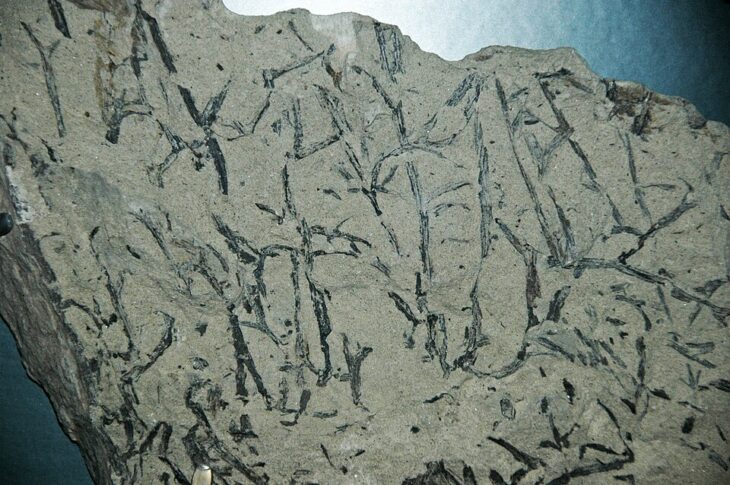Over 350 million years ago, the first forests began to blanket the Earth and rewire its planetary environment. Geologists call this period the late Paleozoic Era. Scientists have recently suggested that the evolution of land plants triggered a cascade of events that restructured atmospheric and oceanic oxygen levels and marine ecosystems.
Scientists have recorded multiple oxygenation events throughout Earth’s history. The Great Oxygenation Event, around 2,400 million years ago, marked when photosynthetic aquatic bacteria, or cyanobacteria, released oxygen in appreciable amounts to Earth’s atmosphere. The Neoproterozoic Oxygenation Event, between about 850 and 540 million years ago, marked a further increase in atmospheric oxygen and created a suitable environment for animals and multicellular life. After that, researchers think oxygen levels remained low until land plants expanded, roughly 420 to 360 million years ago in the Devonian Period. This expansion caused the Paleozoic Oxygenation Event.
Scientists generally agree that the explosion of complex plant life increased atmospheric oxygen levels through photosynthesis, but the exact timing and cause of the Paleozoic Oxygenation Event remain unclear. Biogeochemists who modeled this event have produced inconsistent timing estimates due to limited constraints from data. Without an established timeline, researchers find it difficult to determine what caused it.
To address this issue, researchers from Australia and Canada sampled various reefs formed at ocean basin margins during the Devonian. They analyzed the chemical records of oxidation and reduction reactions preserved in reef rocks, called carbonates. Carbonate rocks store chemical signatures of the ocean environment when they formed. These researchers focused on chemical signatures that can reveal ocean oxygen concentrations, also known as redox conditions. They studied different carbonate rocks that formed in shallow to deep waters to see how oxygen varied at water depths of about 200 meters, or 650 feet.
The team developed a new way to examine past ocean redox conditions by measuring the element cerium, denoted Ce, in carbonate rocks. They chose this element because cerium’s behavior in seawater depends on how much oxygen is around. Reef organisms build carbonate rocks from dissolved carbonate in the seawater. If the seawater is oxygen-rich, minerals like magnesium oxides and iron oxides take up cerium and reduce its concentration in seawater, producing a negative cerium anomaly in the associated carbonates. If the seawater is oxygen-poor, these oxides can’t form, so Ce stays in seawater and becomes part of the carbonate. Analyzing cerium anomalies in reef carbonates allowed the researchers to estimate the change in shallow marine oxygen levels over time.
The researchers took samples of reefs that formed during the Cambrian period, between 541 and 485 million years ago, the Devonian period, between 419 and 359 million years ago, and the Mississippian period, between 359 and 323 million years ago, in Australia, Canada, and Ireland. They measured the abundance of Ce in these rocks using an analytical method called mass spectroscopy. Then, they calculated Ce anomalies in each sample.
The researchers found that the Ce anomalies generally decreased from Cambrian to Mississippian samples, indicating an increase in shallow marine oxygen levels. They also found that each period had distinct Ce profiles. The oldest carbonate samples from the Cambrian to Lower Devonian had weak Ce anomalies, indicating low oxygen levels in the ocean. The Upper Devonian to Mississippian samples had stronger Ce anomalies, indicating higher oxygen levels. Within the Mississippian samples, they reported variable Ce anomalies, highlighting variability in oxygen levels.
The team suggested that the variable Ce anomalies in the late Mississipian period reflected unstable shallow waters. They interpreted their chemical evidence to suggest that previous oxygenation events were not permanent due to fluctuating climate and biogeochemical conditions that resulted in low oxygen amounts deep in the ocean. Therefore, when oxygen-poor water rose into shallower waters, it triggered mass extinctions by creating uninhabitable conditions for the dominating fauna at the time. They stated the extinctions could also be due to more nutrient runoff from expanded deep-rooted forests on land.
The researchers concluded that the evolution of land plants caused the atmosphere to lose carbon dioxide and receive more oxygen. This increased oceanic oxygen and created a habitable environment for oxygen-dependent species, like fish. They remarked that this restructuring set the stage for complex evolutionary advancements and diverse groups of modern marine life.


